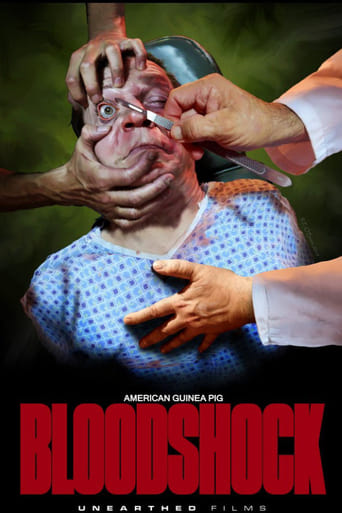Matthew-traugh
The American Guinea Pig franchise is the American take on Japan's now infamous and banned series of films that all fell under the series name "Guinea Pig". The Guinea Pig series were a collection of notorious cult films that emerged out of the Japanese underground in the mid to late 80s to early 90s. The first film in this series, The Devil's Experiment, centered on a kidnapped woman who is held captive in a warehouse where she is exposed to a series of tortures inflicted by her captives who are exploring the human body's threshold for pain. This film's narrative holds distinct similarities to the plot of Bloodshock; and this is intentional.The American Guinea Pig series pays clear homage to its original Japanese predecessor, and this is seen in the plot similarities between the films within the two series. The first film of the American Guinea Pig series, Bouquet of Guts and Gore, actually contains plot components that connects itself to the original Japanese Guinea Pig film, Flower of Flesh and Blood. Similarly, the third film in the American Guinea Pig series, Sacrifice, shares clear plot similarities with the original Guinea Pig film, He Never Dies. This model is no different when it comes to Bloodshock.Bloodshock also centers its focus on a captive person, being held against their will, and forced to endure torturous experiments by the hands of the individuals holding them captive. Unique to The Devil's Experiment, rather than examining the human body's threshold for pain, Bloodshock's experimenters are harvesting the blood of their captive. The reason for this is interesting. During the infliction of pain and stress, the body releases chemicals called endorphins. These endorphins interact with the receptors in the brain that reduce your perception of pain. Endorphins also trigger a positive feeling in the body, similar to that of morphine. These experimenters are using their victim's blood as a new kind of recreational drug. The film's victim is being used as crop to harvest.This approach is intriguing and allows the film to exhibit similar graphic scenes of torture and violence, as in The Devil's Experiment, while having a story that is more complex and allows the film to explore untouched areas that the original Guinea Pig series was never able to reach. Additionally, the practical effects in this film are quite impressive and are a definite step up in terms of realism and graphic imagery from the original series. That said, this film does not come without its flaws. For one, some of the acting in this film is quite awful. This is to be expected with any low budget indie endeavor, and often can be dismissed or forgiven. Unfortunately, when it comes this film, it extends into damaging the picture. Most prominent, there is a scene where the film's protagonist is held in a chair where a large man is punching him in the face. He is then hit in the knee caps with a large hammer. These blows are clearly fake, to a point where it is nearly comical. This poor acting in contrast to the film's magnificent practical visual effects creates an uneven, sloppy, and at times silly juxtaposition.Furthermore, the filmmakers attempted to take the series in a more artistic direction, presenting the film almost entirely in black and white, and giving the film an ambient and eerie score. Many have argued that the black and white decision hurt the film. I personally do not hold this perspective. I found the black and white to be vital in regard to the film's climax, which I will not spoil. I do however find issue with the film's sloppy audio editing. The film's score is powerful, yes, but I felt that he filmmakers relied too heavily on it for the picture's tone and atmosphere. Going so far as compromising necessary sound effects that would have enhanced practical imagery in exchange for creepy sounds of ambiance. The film's climax does save the picture to a degree, where a gruesome finally of passion, self-destruction, beauty, lust and gore all flood the screen in vivid detail. Unfortunately, this is short lived once the credits start to role. The film's credits are interspersed with scenes that attempt to add to the film's plot, but ultimately just feel like unnecessary filler, and actually hurt the picture. Out of the four American Guinea Pig films that have been released thus far, I would consider Bloodshock to be the weakest of the bunch. That does not mean that the film does not have some redeeming qualities. It is still a brutal and visceral picture but compared to the other films in the series Bloodshock just doesn't pack the same punch.
Michael Ledo
This is black and white gore porn. At least "Centipede 2" made sense. This one has no rhyme or reason. Being as it is black and white the gore effect was lessened...well the last 15 minutes has color if you make it that far. Our main character is in a cell and gets "experimented" on i.e. cut out his tongue, beat his knee with a hammer etc. (No power tools) . I initially suspected they are supposed to be making a snuff film, but even at that, it wasn't entertaining. He communicates with the person in another cell by passing notes.There is about 30 seconds at the end that ties this film together...sort of.Bloody sex and nudity that I don't wish to see again. A film you can watch and burn to prevent others from seeing it. I like "Blood Sucking Freaks" and had a fondness for "Centipede 2." This one I didn't like any scene at all.
